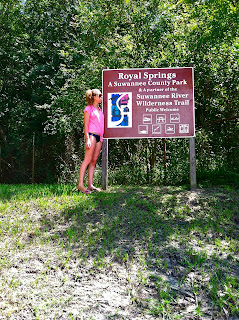 |
| The turquoise glow of the spring amidst the trees (and some friendly danger/death/ swim at your own risk signs). |
 |
| Looking out the algae-filled spring run towards the Suwannee. |
When we pulled into the parking lot, we were alone. It was
kind of eerie seeing a park with a beautiful spring totally empty on a Sunday
morning, but we just assumed everyone was still sleeping or at church. We walked
down to the spring to check out the basin and find the best entrance into the
water and found that the spring was low but clear, first visible as a turquoise
glow in the middle of the forest. While one of the staircases was blocked off
with caution tape because it no longer led anywhere near the water and the
rocks beneath the platform were slowly eroding away, there was one staircase
that led down to a decent area for entry.
So after moving the car closer to the functional staircase,
wiggling into our wetsuits, realizing I forgot my memory card for the
underwater camera, and setting up our gear while battling the mosquitoes, we crossed
the mini rocky beach (that was clearly supposed to be under water) and
descended. Thankfully my mind was immediately taken off the fact that I felt
like I was missing a limb without camera in hand when I was greeted by a tiny bluegill sunfish (Lepomis
macrochirus mystacalis) that came within inches of my mask. We were also
immediately overwhelmed by the amount of brown and green algae in the basin and
decided to head over to the cavern first.
The entrance to the cavern is huge, truly representing what
Harry later called “ledge diving”. The entrance is as wide as the entire cavern
room, so there is really no danger of losing sight of the light or getting
trapped. I explored every nook and cranny of the wall and hit a max depth of 53
feet, so it’s relatively shallow as well. Hiding amongst the little bedding
planes and holes in the limestone, my light brought to life a largemouth bass (Mircopterus salmoides floridanus) and
some tiny albino-looking fish that looked like juvenile sunfish (only about an
inch long!) – I’m guessing they were flagfish (Jordanella floridae) but can’t be totally sure until I go back with
my camera.
Over in one corner of the cavern, there are multiple sand
boils that again reminded me of a boiling witches cauldron. The only difference
being the water is a chilling 72 degrees, far from boiling. After playing
around in the sand boils, we swam around exploring the basin for about 20
minutes. We spotted what looked like a Suwannee Cooter (also called the
Suwannee Chicken, Pseudemys concinna
suwanniensis), which essentially looks like a painted turtle. The word
‘cooter’ actually comes from the African language Malinké word ‘Kuta’ meaning
turtle. There are literally dozens of different freshwater turtle and slider
species that thrive in the Suwannee, so I may be mistaken, but anyway, this
turtle was hanging out at the surface then dove down and disappeared into the
algae around the walls of the basin. We were also entertained by a school of
almost a dozen spotted suckers (Minytrema
melanops) and tiny flounder-looking fish that are actually part of the sole
family called hogchokers (Trinectes
maculates). These hogchokers blended almost perfectly with the algae when
they barely coated themselves with a thin layer of the overly abundant silt on
the bottom of the basin. As I was sneaking up on the T. maculates and touching their tails before they bolted away, I
also tried sticking my arm in the silt… I stopped when it hit my elbow and
declared the unscientific measurement of “a lot” of silt, most likely due to
the recent flooding. But as long as you were careful not to kick up the bottom
and stayed out of the cave, it was beautiful – definitely coming back to take
pictures J
 |
| Pink shirt at the bottom of the stairs and pink towel at the top... I wonder who those belong to? And these are the stairs that definitely are supposed to go into the water... |







